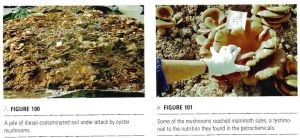Paul Stamets
Mycoremediation
Mycoremediation is the use of fungi to degrade or remove toxins from the environment.
Mycoremediation practices involve mixing mycelium into contaminated soil, placing mycelial mats over toxic sites, or a combination of these techniques, in onetime or successive treatments[1]
Mycelium acts as a catalyst for other animals, bacteria and plants to populate sites of contamination to break down toxic chemicals and contaminates.
The powerful enzymes secreted by certain fungi digest lignin and cellulose, the primary structural components of wood. These digestive enzymes can also break down a surprisingly wide range of toxins that have chemical bonds like those in wood... These complex mixtures allow the mycelium to dismantle some of the most resistant materials made by humans or nature. Since many of the bonds that hold plant material together are similar to the bonds found in petroleum products, including diesel, oil, and many herbicides and pesticides, mycelial enzymes are well suited for decomposing a wide spectrum of durable toxic chemicals. Because the mycelium breaks the hydrogen-carbon bonds, the primary nonsolid byproducts are liberated in the form of water and carbon dioxide. More than 50 percent of the organic mass cleaves off as carbon dioxide and 10 to 20 percent as water; this is why compost piles dramatically shrink and ooze leachate and they mature.[2]
Oil Spills
In Washington Paul Stamets conducted an experiment at a maintenance yard used by the Washington State Department of Transportation in Bellinghman, Washington. The site was contaminated with diesel and oil at levels approaching 20,000 parts per million of total aromatic hydrocarbons. The department of transportation
...set aside 4 piles of diesel-contaminated soil... ...Each pile measured about 3 to 4 feet in height, 20 feet in length, and 8 feet in width. Into one of the piles (measuring about 10 cubic yards), we mixed about 3 cubic yards of pure culture sawdust spawn, an amount roughly equal to 30 percent of the pile. We placed the spawn in layers, sandwiching the soil in between... ...The other piles received no mycelia. Of these, 2 were given bacterial treatments and 1 was an untreated control. Our myceliated pile was covered with shade cloth, while black plastic tarps were pulled over the other piles to keep out rain. Approximately 4 weeks later, part of our team returned to the piles and pulled back the tarps on the non-mycelium-treated dirt. All 3 of the piles were black and lifeless and stank like diesel and oil.[3]
The pile of soil inoculated with the sawdust mycelium spawn was covered in oyster mushrooms, the soil was light brown and no longer smelled of diesel and oil. For five weeks the mushrooms continued to fruit, lay spores, and then died back, during fruiting/ sporulating period,
...they attracted insects that feasted upon the succulent fruiting bodies and laid their eggs in them. Soon squirming larvae attracted birds, which brought seeds and turned our pile into an oasis of life. (Seeds may have also blown in with the wind.) Other mushroom species-secondary decomposers- appeared as the pile's biosphere diversified. When mushrooms rotted, bacteria and predator fungi rose to the occasion.[4]
Experiments of this nature show the potential of mycelium to help regenerate the environment- reversing the destructive effects of fossil fuels and capitalism.
